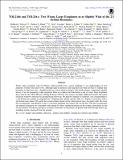Files in this item
TOI-216b and TOI-216 c : two warm, large exoplanets in or slightly wide of the 2:1 orbital resonance
Item metadata
| dc.contributor.author | Dawson, Rebekah I. | |
| dc.contributor.author | Huang, Chelsea X. | |
| dc.contributor.author | Lissauer, Jack J. | |
| dc.contributor.author | Collins, Karen A. | |
| dc.contributor.author | Sha, Lizhou | |
| dc.contributor.author | Armstrong, James | |
| dc.contributor.author | Conti, Dennis M. | |
| dc.contributor.author | Collins, Kevin I. | |
| dc.contributor.author | Evans, Phil | |
| dc.contributor.author | Gan, Tianjun | |
| dc.contributor.author | Horne, Keith | |
| dc.contributor.author | Ireland, Michael | |
| dc.contributor.author | Murgas, Felipe | |
| dc.contributor.author | Myers, Gordon | |
| dc.contributor.author | Relles, Howard M. | |
| dc.contributor.author | Sefako, Ramotholo | |
| dc.contributor.author | Shporer, Avi | |
| dc.contributor.author | Stockdale, Chris | |
| dc.contributor.author | Zerjal, Marusa | |
| dc.contributor.author | Zhou, George | |
| dc.contributor.author | Ricker, G. | |
| dc.contributor.author | Vanderspek, R. | |
| dc.contributor.author | Latham, David W. | |
| dc.contributor.author | Seager, S. | |
| dc.contributor.author | Winn, J. | |
| dc.contributor.author | Jenkins, Jon M. | |
| dc.contributor.author | Bouma, L. G. | |
| dc.contributor.author | Caldwell, Douglas A. | |
| dc.contributor.author | Daylan, Tansu | |
| dc.contributor.author | Doty, John P. | |
| dc.contributor.author | Dynes, Scott | |
| dc.contributor.author | Esquerdo, Gilbert A. | |
| dc.contributor.author | Rose, Mark | |
| dc.contributor.author | Smith, Jeffrey C. | |
| dc.contributor.author | Yu, Liang | |
| dc.date.accessioned | 2019-08-09T14:30:04Z | |
| dc.date.available | 2019-08-09T14:30:04Z | |
| dc.date.issued | 2019-07-17 | |
| dc.identifier | 260484875 | |
| dc.identifier | 5051ddbd-415c-4715-948f-e980cee22986 | |
| dc.identifier | 000475797700006 | |
| dc.identifier | 85072042250 | |
| dc.identifier.citation | Dawson , R I , Huang , C X , Lissauer , J J , Collins , K A , Sha , L , Armstrong , J , Conti , D M , Collins , K I , Evans , P , Gan , T , Horne , K , Ireland , M , Murgas , F , Myers , G , Relles , H M , Sefako , R , Shporer , A , Stockdale , C , Zerjal , M , Zhou , G , Ricker , G , Vanderspek , R , Latham , D W , Seager , S , Winn , J , Jenkins , J M , Bouma , L G , Caldwell , D A , Daylan , T , Doty , J P , Dynes , S , Esquerdo , G A , Rose , M , Smith , J C & Yu , L 2019 , ' TOI-216b and TOI-216 c : two warm, large exoplanets in or slightly wide of the 2:1 orbital resonance ' , Astronomical Journal , vol. 158 , no. 2 , 65 . https://doi.org/10.3847/1538-3881/ab24ba | en |
| dc.identifier.issn | 0004-6256 | |
| dc.identifier.other | Bibtex: urn:a98086b25e9bd64d6b7836955448af33 | |
| dc.identifier.uri | https://hdl.handle.net/10023/18286 | |
| dc.description | K.H. acknowledges support from STFC grant ST/R00824/1. | en |
| dc.description.abstract | Warm, large exoplanets with 10–100 day orbital periods pose a major challenge to our understanding of how planetary systems form and evolve. Although high eccentricity tidal migration has been invoked to explain their proximity to their host stars, a handful reside in or near orbital resonance with nearby planets, suggesting a gentler history of in situ formation or disk migration. Here we confirm and characterize a pair of warm, large exoplanets discovered by the TESS Mission orbiting K-dwarf TOI-216. Our analysis includes additional transits and transit exclusion windows observed via ground-based follow-up. We find two families of solutions, one corresponding to a sub-Saturn-mass planet accompanied by a Neptune-mass planet and the other to a Jupiter in resonance with a sub-Saturn-mass planet. We prefer the second solution based on the orbital period ratio, the planet radii, the lower free eccentricities, and libration of the 2:1 resonant argument, but cannot rule out the first. The free eccentricities and mutual inclination are compatible with stirring by other, undetected planets in the system, particularly for the second solution. We discuss prospects for better constraints on the planets' properties and orbits through follow-up, including transits observed from the ground. | |
| dc.format.extent | 1556349 | |
| dc.language.iso | eng | |
| dc.relation.ispartof | Astronomical Journal | en |
| dc.subject | Planets and satellites: detection | en |
| dc.subject | Planets and satellites: dynamical evolution and stability | en |
| dc.subject | QB Astronomy | en |
| dc.subject | 3rd-DAS | en |
| dc.subject.lcc | QB | en |
| dc.title | TOI-216b and TOI-216 c : two warm, large exoplanets in or slightly wide of the 2:1 orbital resonance | en |
| dc.type | Journal article | en |
| dc.contributor.sponsor | Science & Technology Facilities Council | en |
| dc.contributor.institution | University of St Andrews. School of Physics and Astronomy | en |
| dc.contributor.institution | University of St Andrews. St Andrews Centre for Exoplanet Science | en |
| dc.identifier.doi | https://doi.org/10.3847/1538-3881/ab24ba | |
| dc.description.status | Peer reviewed | en |
| dc.identifier.grantnumber | ST/R00824/1 | en |
This item appears in the following Collection(s)
Items in the St Andrews Research Repository are protected by copyright, with all rights reserved, unless otherwise indicated.

